How to choose the right focus keyword + examples

In Yoast SEO, you’ll find a focus keyphrase input field for every page on your site. Here, you can enter the keyword or keyphrase you’d like the page to rank for in Google. Next, Yoast SEO will check the page’s content to see if search engines will recognize what it is about. In this post, we’ll explain the purpose of a focus keyphrase and how to choose it well. We will also give a couple of example keywords and focus keyphrases.
Looking for keyphrase suggestions? When you’ve set a focus keyword in Yoast SEO, you can click on ‘Get related keyphrases’ and our Semrush integration will help you find high-performing keyphrases!
Key takeaways
- A focus keyword is the search term you want your page to rank for in Google; Yoast SEO evaluates your content against this keyphrase.
- Adding quality content regularly is essential, but optimizing it based on a keyword strategy is crucial for better search engine recognition.
- Use tools like Yoast SEO and Semrush to find related long-tail keywords and analyze their search volume for effective optimization.
- Consider audience search intent by googling your focus keyword; check how existing content meets user expectations.
- Not every page requires a focus keyword; assess the relevance and long-term value of the content before optimizing.
What is a focus keyword?
The focus keyword or keyphrase is the search term you want a page or post to rank for. When people search for that phrase, they should find you. The plugin or app evaluates the page’s content if you set a focus keyphrase for a page with Yoast SEO in WordPress or Shopify. It provides feedback on improving the content to increase your chances of ranking higher for that search term.
You’ll find the input field for your focus keyphrase in the Yoast SEO sidebar on the right side of your editor. If you’re working in WordPress and don’t see the Yoast SEO sidebar, click the Yoast icon on the top right of your screen first. If you’re working in Shopify, click the ‘More actions’ option at the top of the screen to optimize in Yoast SEO.
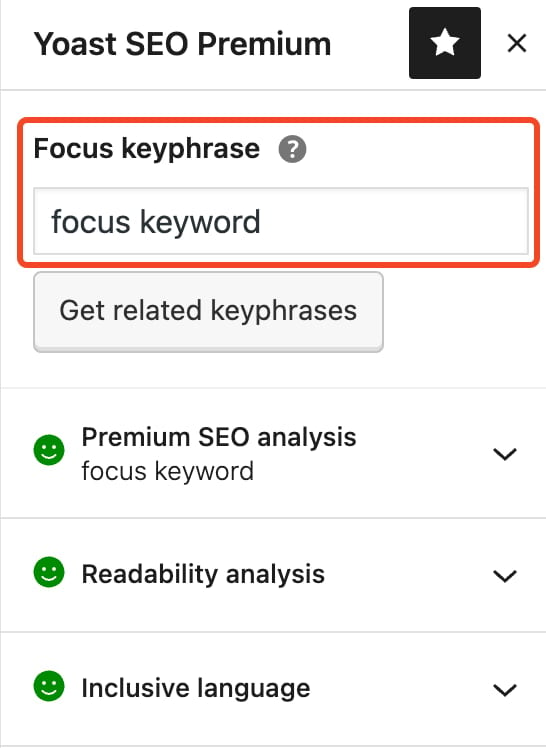
If you’re using WordPress, you can also find the focus keyphrase input field in the Yoast SEO meta box below the post editor. We’ve used the focus keyphrase “focus keyword” as an example.
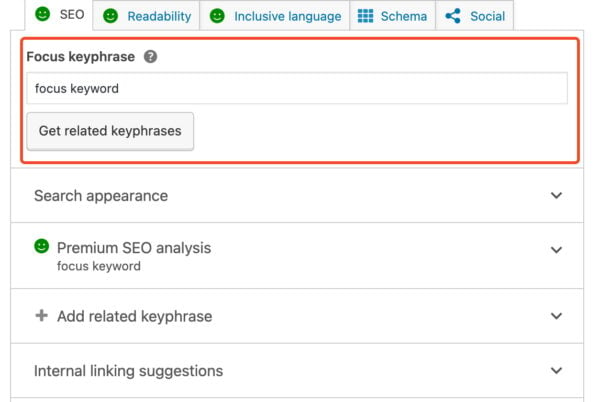
The feedback to improve your content is in the SEO analysis tab. If you amend your page with this feedback, search engines will be able to recognize what your post or page is about more easily.
Check out this video to see how it works:
Why use a focus keyphrase?
Regularly adding quality content to your website or blog is a good SEO strategy. Google sees that your website is active because you add new information and increase the volume of your content.
But randomly adding content to your site isn’t very useful. You have to craft a keyword strategy, and based on that strategy, you should create high-quality content your audience is looking for. When you write those articles, optimizing them for the keyphrases you’re aiming at is important. And that’s what Yoast SEO helps you with. Let’s go over some examples of good focus keywords.
Focus keyphrase and keyword examples
Based on our experience with keywords and the Yoast SEO analyses, here are three practical examples of good focus keywords or keyphrases, along with their context and rationale:
Example focus keyphrase: “Search volume analysis”
Context: The article highlights the importance of checking the search volume for keyphrases to gauge potential traffic.
Reason: This keyphrase appeals to users who want to understand how often certain keywords are searched and how to prioritize them in their SEO strategy. It is essential for content that guides evaluating and choosing keywords based on quantitative data.
Example focus keywords: “Content optimization for SEO”
Context: The article provides tips for optimizing content to improve search engine recognition and ranking.
Reason: This keyphrase is relevant for users interested in refining their content to meet SEO best practices. It is crucial for articles or guides to offer actionable steps to enhance content quality and searchability.
Example long-tail focus keyphrase: “Effective keyword research tools for small businesses”
Context: Small business owners and marketers often have limited resources and need cost-effective solutions. This article reviews or recommends tools specifically designed to help small businesses conduct efficient keyword research.
Reason: This keyphrase is aimed at small business owners or marketers seeking tools tailored to their specific needs in conducting keyword research.
How to choose a focus keyphrase
In our opinion, there are at least three things you should do to determine which keywords or keyphrases you should optimize your blog posts for:
- Find a focus keyword people search for
- Research the search volume
- Google your keyphrase
Let’s elaborate on these steps a bit:
1. Find a focus keyword people search for
As mentioned above, your keyword strategy should have given you some idea of what you want to write about. You should create a keyword strategy if you haven’t yet. You can read our ultimate guide to keyword research or take our keyword research training course if you need help finding your perfect keywords and keyphrases.
Long-tail keywords
If you want a post or page to rank, you can increase your chance of success by aiming for long-tail keywords. Long-tail keywords often exist of more words and are less searched for than very popular ‘head’ keywords. However, being less popular also means less competition, and the chances of conversion are usually higher. We elaborate on this in our guide to content SEO.
Tools that help you find long-tail and related keyphrases
When you’ve done your keyword research and know what you want to write about, you can use various tools to find long-tail variants of that keyphrase or related keyphrases.
One of these tools is at your disposal in Yoast SEO in WordPress and Shopify: a Semrush integration to easily find related keyphrases. When you are a user of our WordPress plugin or Shopify app, and you know what to write about, you can click on ‘Get related keyphrases’ below your focus keyphrase to see what phrases people search for in Google:
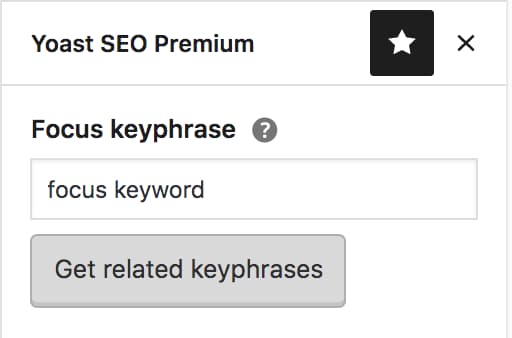
A screen will open with related keyphrase suggestions:
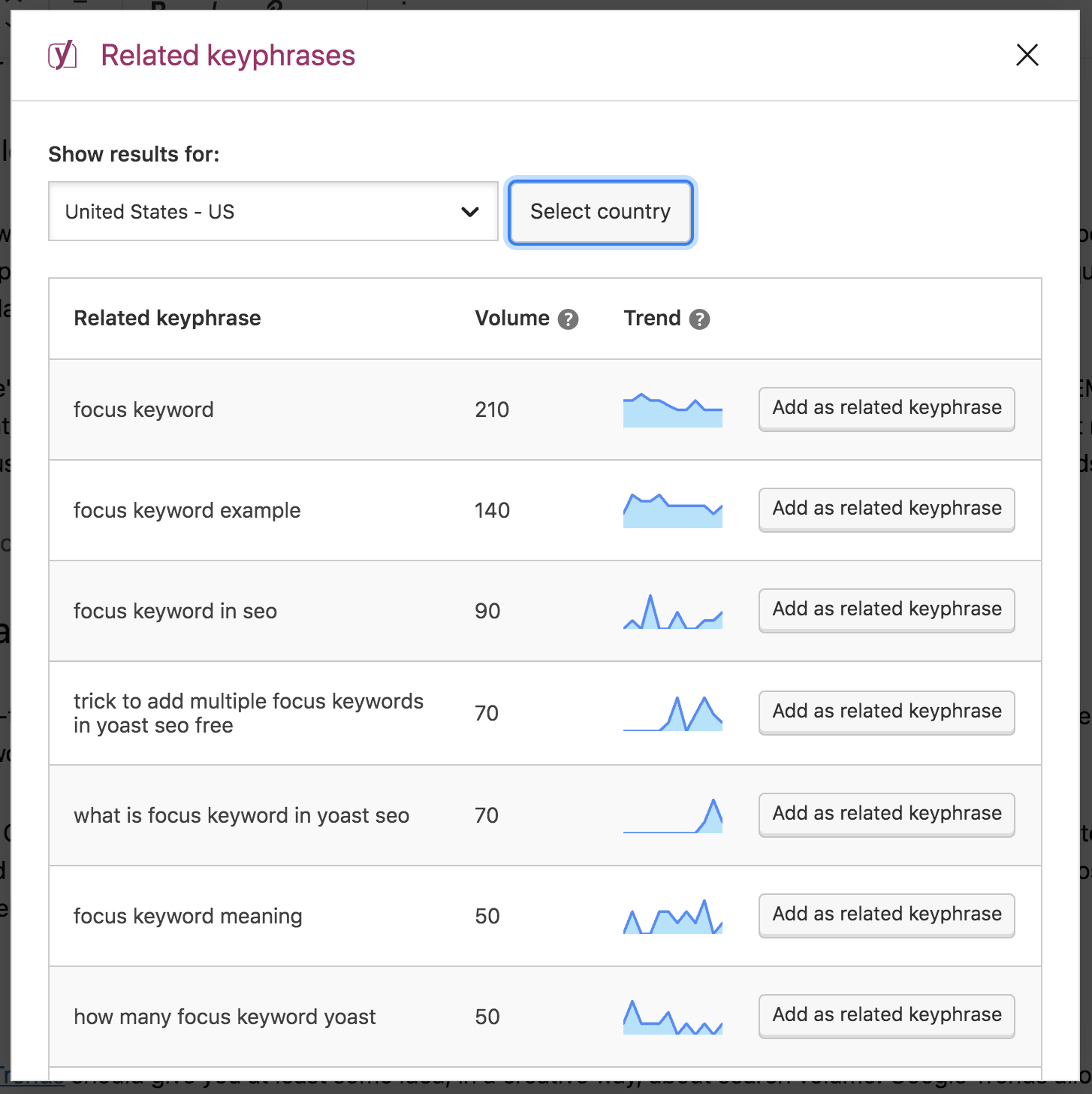
2. Check the search volume for your keyphrase
Once you have found a long-tail search term you want to rank for, you should research whether there are many searches for that keyword or phrase. This used to require quite some effort: you’d need to dive into Google Adwords or Google Trends. However, as you can see in the image above, you can now easily get information about related or long-tail keyphrases in Yoast SEO if you’re on WordPress or Shopify!
For instance, you can check out the search volume (how often it is searched for in a specified period) and trends (how that changed over time). Now, you can easily compare the related keyphrases and decide which one(s) you want to focus on in your current or other posts.
Add more than one keyphrase
Optimizing your post for related keywords can improve the quality of your content: it will make it more complete and easier for Google to understand. If you want to set one of these related keywords for your posts, you can do so with one click in Yoast SEO Premium for WordPress and Shopify. Afterward, return to the post editor and optimize your post for the new related keyword.
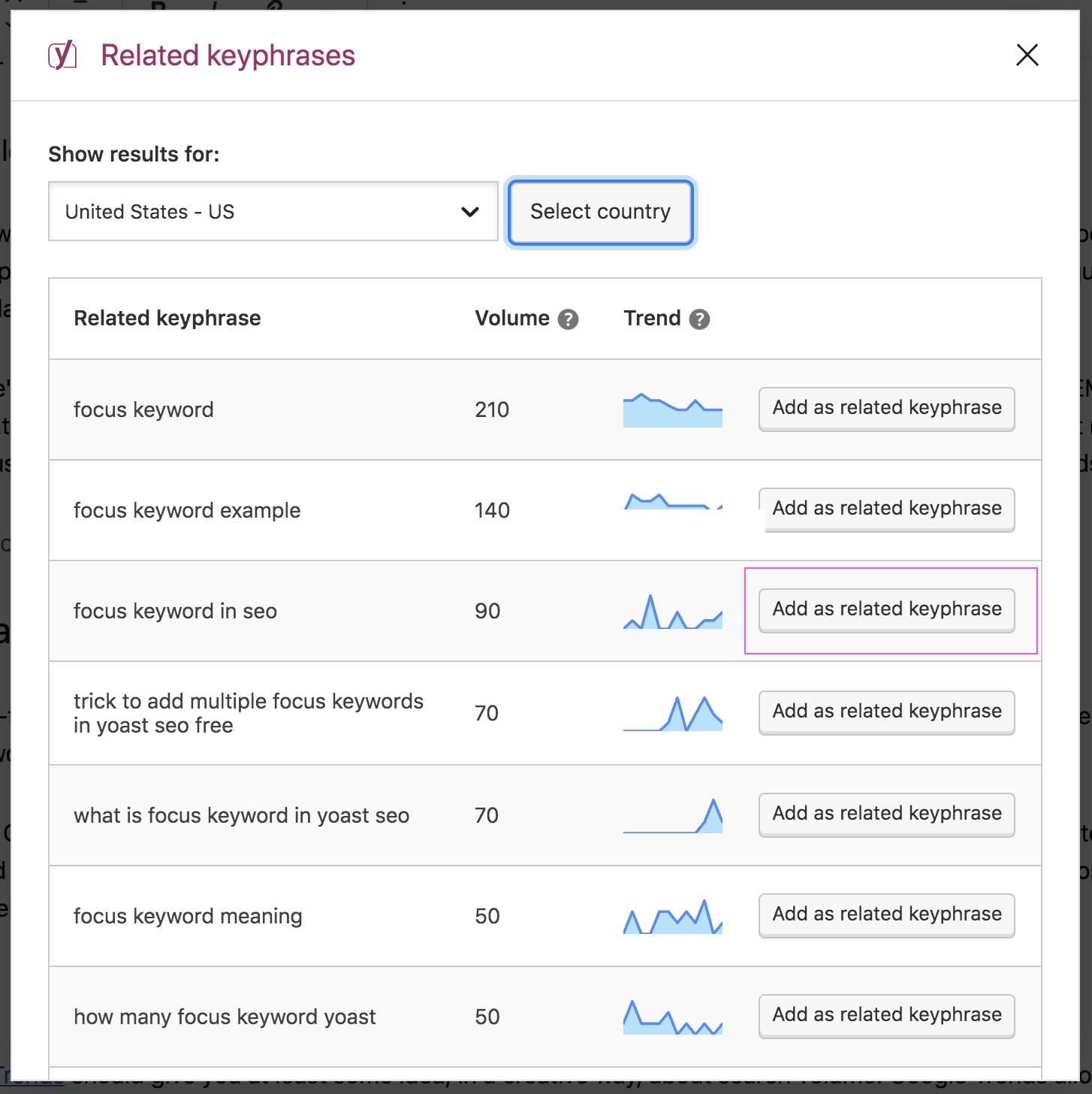
Buy Yoast SEO Premium now!
Unlock the premium content analysis and much more for your WordPress site with the Yoast SEO Premium plugin!
If you’re a Shopify user and want to maximize your SEO efforts, check out our Yoast SEO for Shopify app if you don’t have it already!
Check posts that already rank
If you already have some (blog) posts that rank well for good terms, you will know how many visitors these posts attract. Using Google Trends to compare the focus keyphrases of older posts (which you can view the statistics for) with the focus keyphrase you have in mind for your new post could give you some idea about the potential traffic. Make sure to choose older posts most similar to the post you plan to write. If you plan to choose a long-tail keyword, compare posts with long-tail keywords.
For instance, this post about the focus keyphrase could be compared with a post about snippet previews, a related feature of Yoast SEO we already wrote about. In WordPress and Shopify, you could do this by using the Semrush integration in the Yoast SEO plugin:
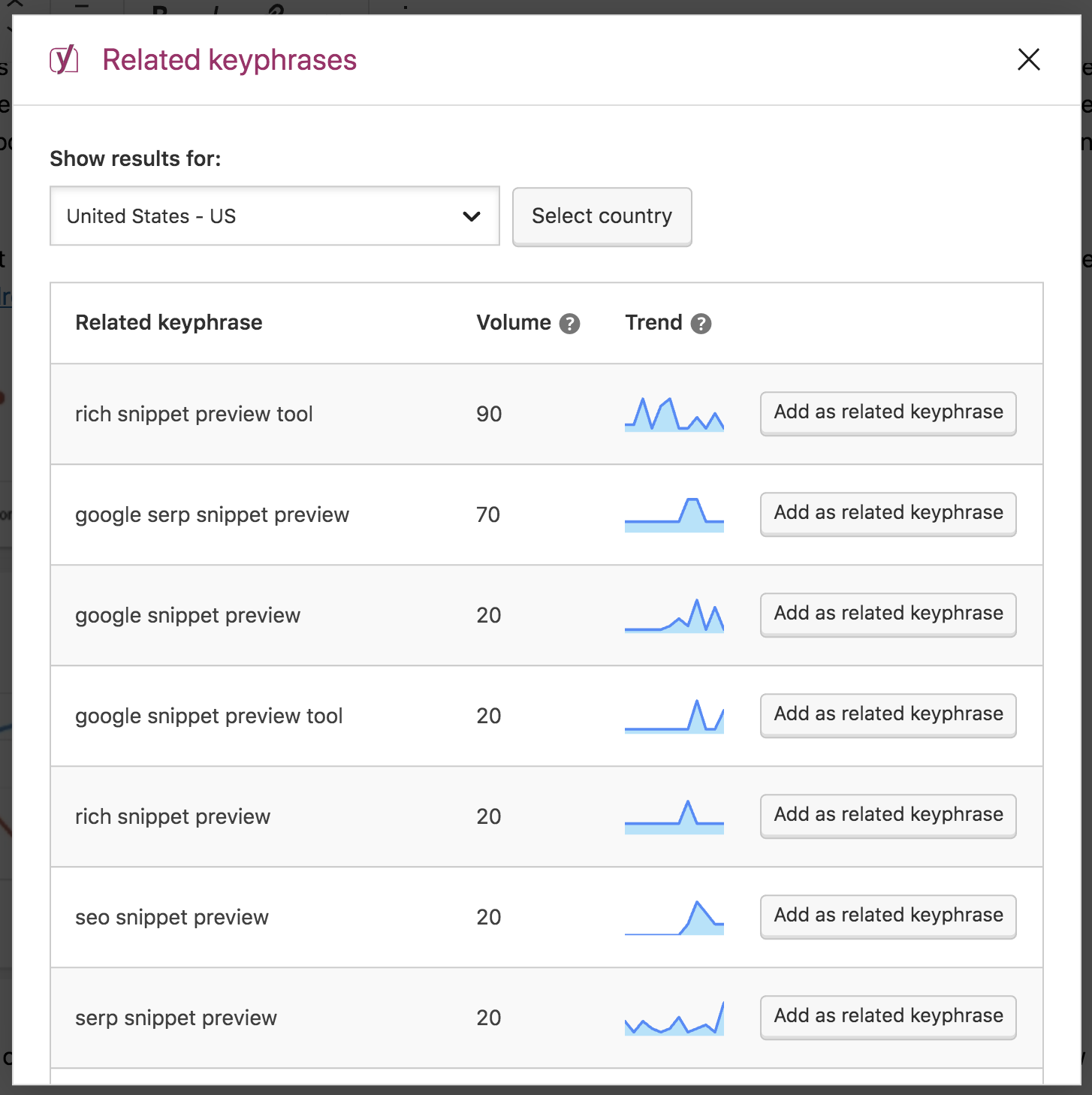
As you can see, the amount of traffic is a bit lower but still comparable. We know the search traffic to our snippet preview post is reasonably good, so we know it’s worth optimizing for.
Another good way to use the Semrush integration in the Yoast SEO plugin is when considering several (long-tail) focus keywords. Because it will easily show you which search term will have the highest search volume compared to another, it will help you decide which long-tail keyword is most commonly used in search.
For additional tools, see our post on keyword research tools.
3. Google your proposed focus keyword!
Apart from knowing which search terms people use, you need to know whether your post or page idea fits the needs and expectations of those who use these search terms. In other words, you need to determine your audience’s search intent. A quick way to find out is by Googling your proposed (sets of) keywords yourself.
Check the search engine result pages
Take the time to look at the search engine result pages (SERPs) Are the articles in the Google results of similar character to your article? Could your article fit the results shown on these search pages? If you write a blog post or page for this exact focus keyword, you aim to get your post amongst these results.
The type of content shown in the search results will help you decide what content to create. Does Google show product pages or blog posts? Or perhaps video or images? If there’s one dominant type, Google probably “thinks” this is the type of content people are looking for, so it’s worth investing time in creating that type of content, too. Of course, the results change when the search intent changes. Remember: you’ll have to beat the other search results, so only do this when you can create something truly outstanding and useful for your audience!
Content of the results pages
Be sure to use the content of the result pages as an inspiration for your blog post. However, do NOT copy content. Use the result pages to check if you missed information or arguments for your post or page. Most importantly, you must see how to make your post stand out. How could your post be better, funnier, and more original than the post displayed in the result pages? Try to create content that will make the audience click and share!
Check out social media and forums
Another great tip: Check what people say about this topic on social media and various online forums. This will probably give you loads of input for your post or page. You can directly address the questions people have and the difficulties they encounter regarding this topic. On top of this, it will help you use the right wording, which is crucial if you want to reach your audience.
Don’t forget to repeat your research now and then!
Remember that search suggestions change constantly and are often tuned to what you’ve been searching for. When we searched for the term “focus keyword” some time ago, the suggested keywords differed from those we got a couple of weeks ago.
Suggest changes based on people’s problems, so monitoring it for important keywords makes sense. New results can give you input for your post or other related posts.
Yoast SEO checks the quality of your keyphrase
A good focus keyword for your post is essential if it wants to stand a chance in the search engines. Therefore, Yoast SEO checks some aspects of your keyphrase, both in our WordPress plugin and our Shopify app. First, we check the length of your keywords to ensure your keyphrase isn’t too long. In addition, Yoast SEO checks whether the keyphrase only consists of function words.
The function word check in Yoast SEO
Function words (words such as the, a, and, or, have) carry very little meaning. They don’t help Google figure out the topic of the copy. Even though it’s unlikely that you come up with such a keyphrase yourself, it can happen when you’re distracted while typing in your keyphrase. For instance, you could have typed [the] instead of [the best movies of 2020]. To prevent keeping your focus keyphrase like this, Yoast SEO will show a warning with a grey bullet in the SEO analysis of your post and help you stay focused!
In rare cases, you might mean to rank for a phrase consisting of only function words. For instance, if you are writing a post about a meme called “Why would you do that?”. In exceptional cases like this, you can avoid getting a red bullet by adding a double quote before and after your keyphrase. By doing so, our tool will look for the exact match of this phrase, and the warning will disappear.
Read more about the function word check in Yoast SEO.
Should every page have a focus keyphrase?
People often ask us whether their About page or contact page should have a focus keyword and, if so, what it should be.
The answer is easy: not every page needs a focus keyword. Your contact page should be easily reachable. It might, for instance, need to rank for “<company name> address.” That probably doesn’t make sense as a focus keyword, though, so it’s perfectly fine to leave it empty.
Also, ask yourself: Do I want this post to rank in the long term? Some posts, such as temporary announcements, are probably not worth optimizing.
Conclusion and further readings
Choosing a perfect focus keyword or keyphrase is not an exact science. You should aim for a combination of words used by a search audience. Aim for a keyphrase that is relatively high in volume and will suit your audience.
This article has shown several examples of focus keyphrases and keywords. We have more articles on this subject: you can read about keyword research, content writing, and improving your site structure. We’ve also combined these different topics into an SEO copywriting course.
Read more: SEO copywriting: the ultimate guide »

